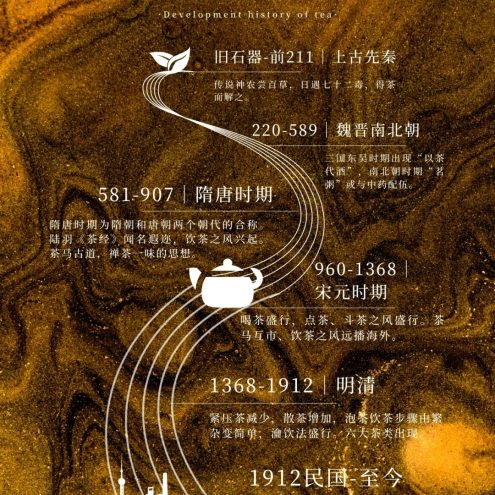The Evolution of Chinese Tea Culture: A Fun Journey Through History
Hey tea lovers! 🌿 Let’s take a chill trip through time and explore how Chinese tea culture has evolved over thousands of years. From its early days as a medicinal herb to becoming the ultimate drink for relaxation and social vibes, tea has been through a lot! So, grab your favorite cup of tea, and let’s dive into this fascinating story. 😊
Chinese tea culture, with its rich history and profound influence, has undergone significant transformations over thousands of years. From its early use as a medicinal herb to its current status as a beloved beverage, the evolution of tea drinking in China reflects the country’s social, cultural, and technological advancements.
The OG Tea Days: Medicine & Food 🍃💊
Back in the pre-Qin period (before 221 BCE), tea wasn’t even a drink—it was medicine! 🥼 People would chew fresh tea leaves to get that bitter, healing juice. Later, they started boiling the leaves in water and drinking the brew like a herbal remedy. Oh, and guess what? Tea was also mixed into food, like a fancy ingredient in soups and dishes. So yeah, tea was basically the ancient Chinese version of a superfood smoothie. 🥗🍵
Qin & Han Dynasties: Tea Gets an Upgrade 🎉
Fast forward to the Qin and Han dynasties (221 BCE–220 CE), and tea started getting a glow-up. 🌟 People began processing tea leaves into cakes, which were dried and stored. When it was time to drink, they’d crush the cake, boil it in water, and add some flavor with ginger, scallions, or orange peel. 🍊 Tea wasn’t just medicine anymore—it became a social thing, like offering your guests a cup of tea to say, “Hey, welcome to my place!” 🏡
Six Dynasties: Tea Soup, Anyone? 🍲
During the Six Dynasties period (220–589 CE), tea got a little… soupy. 🥣 The “porridge tea” method was all the rage—tea leaves were boiled into a thick, soup-like drink. It wasn’t exactly Instagram-worthy, but it got the job done. Tea drinking was still pretty basic at this point, more about function than fancy vibes. But hey, it was a step up from chewing leaves, right? 😅
Tang Dynasty: Tea Becomes an Art Form 🎨
The Tang Dynasty (618–907 CE) was when tea really started to shine. ✨ This was the golden age of tea culture! People started making tea cakes, roasting them, grinding them into powder, and whisking the powder into hot water to make a frothy drink. 🥄 It was like the ancient version of a latte art trend. And guess what? A guy named Lu Yu wrote the first-ever tea manual, The Classic of Tea (Chajing), which basically made tea drinking a legit art form. 🖋️🍵
Song Dynasty: Tea Battles & Frothy Fun 🥊💨
The Song Dynasty (960–1279 CE) took tea to the next level with the “point tea” method. 🎯 This involved whisking powdered tea with hot water to create a creamy, frothy drink. But wait—it gets better! People started having tea competitions to see who could make the best froth and the prettiest tea. 🏆 It was like a barista championship, but way more ancient and way more intense. 😂
Yuan & Ming Dynasties: Bye-Bye Powder, Hello Loose-Leaf! 🍂
The Yuan Dynasty (1271–1368 CE) was a bit of a transition period. Powdered tea was still around, but people started experimenting with stir-fried green tea, which gave tea a more aromatic and flavorful vibe. 🌱 Then, during the Ming Dynasty (1368–1644 CE), loose-leaf tea took over! Emperor Hongwu was like, “No more tea cakes, guys,” and everyone switched to steeping loose tea leaves in hot water. 🚫🍰 This was the birth of the brewed tea method we know and love today. ☕
Qing Dynasty & Beyond: Tea for the Modern World 🌍
By the Qing Dynasty (1644–1912 CE), tea drinking had become super chill. � The steeping method was the go-to, and tea houses became the place to hang out, sip tea, and chat with friends. 🏮 Tea wasn’t just a drink anymore—it was a lifestyle. And today? Well, tea is everywhere, from traditional tea ceremonies to bubble tea shops. 🧋 It’s come a long way from its medicinal roots!
The evolution of Chinese tea culture is a testament to the country’s rich history and cultural depth🍵. From its humble beginnings as a medicinal herb to its current status as a global beverage, tea has played a central role in Chinese society. Each era brought new methods of preparation and consumption, reflecting changes in technology, aesthetics, and social customs. Today, Chinese tea culture continues to thrive, offering a window into the country’s past while remaining a vibrant part of its present. Whether enjoyed in a traditional tea house or a modern café, tea remains a symbol of hospitality, refinement, and the enduring spirit of Chinese culture.
Next time you sip your tea, take a moment to appreciate the rich history behind it. And hey, maybe try whisking your tea like they did in the Tang Dynasty—just for fun! 😉 Cheers to tea, the drink that’s stood the test of time! 🥂🍵











Add comment
You must be logged in to post a comment.